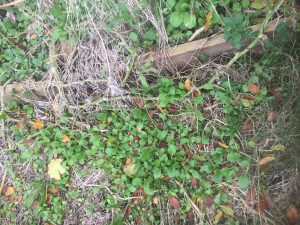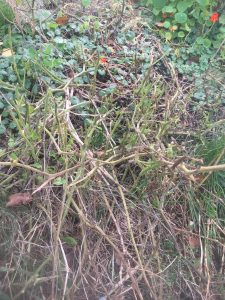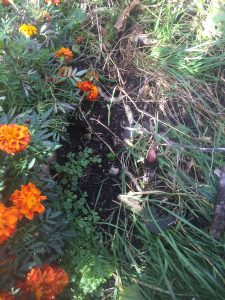Grass seems to have a dual identity in our society.
For many home-owners and property developers, a homogeneous grass lawn is a symbol of status and serenity; it must be protected from invasions of weeds by any means necessary. For others, most notably gardeners, grass IS the noxious weed whose presence must be eliminated.
The boundary between “lawn” and “garden”, the territory controlled by “weeds”, seems to be the site of a perpetual battle that can’t be won. It feels like no matter which side you choose the weeds always win. People go to extreme lengths and expend huge amounts of energy to maintain hegemony over the weeds, but perhaps there is an easier way.
Many gardeners try to keep out grass by constructing wooden-box raised beds. While this does do a pretty decent job of keeping the grass at bay, it brings with it its own set of Challenges. The straight, rigid nature of the boards means that beds most likely cannot be built on contour and cannot be swaled. The wood also directs rain water away from the beds, generally not what we want. And while wooden-box raised beds do a decent job keeping the lawn out of the garden, they present many challenges with keeping the garden out of the lawn!
In our experience with wooden-box raised beds here at the SSPP, we’ve found that their inflexible nature limits the adaptability of the gardens as a whole and prevents them from growing. In one of the boxes, tomatoes, radishes, and lettuce spilled over and dropped their seeds outside the box. When the seeds germinated the following spring, the wooden sides of the box cut right through the would-be-expanded garden. If we had note caged in the garden in the first place, we could have had a much bigger garden bed each year.

So we’ve seen that many seed-bearing plants can expand their territory each year given the opportunity, and that designing for that can allow us to expand our yield, but we also know that grasses, especially rhizomatous and stoloniferous grasses, can take over a garden if not contained. So how do we let the garden grow out without letting the grass come in!?
The key here is to pay careful attention to the margin.
There is much activity at this interface between domains, and through observation and interaction we can negotiate this boundary to our benefit.
Upon depositing mulch and compost around the garden beds, the grass on the edges usually gets somewhat covered. Many vining/sprawling plants like squashes or beans can also cover areas of grass and choke them out. This provides an opportunity for other herbaceous and ground-cover plants to get established that might not otherwise be able to compete with a full grass cover. If this area does not get seeded out to something else, however, the grass usually comes back the following year with a vengeance, strengthened by the mulch and deeper roots. This is why its very important to always leave some plants to mature fully to seed. It may seem like a waste to not harvest that beautiful head of lettuce, but letting it bolt and go to seed can help ensure that the garden stays mostly grass-free; and all you had to do was nothing!

Another good technique, especially when dealing with rhizomatous grasses, is to plant a rhizome barrier of large roots and tubers. We’ve mentioned this concept before in our Guild Highlight, but the basic idea is that plants with large underground storage structures like onions, beets, sunchokes, skirret, tulips, etc., provide a blockade which underground runners from grasses cannot penetrate. When the bulbs/tubers are harvested, they leave behind a hole that can be planted in, perhaps with a perennial element, and the edge can be pushed outward just a little bit further.

Sometimes, though, grasses and other “weeds” pop up in the middle of a garden bed, and no amount of care for the edges will prevent that. In these cases, it is very important to observe and interact. The presence of such an “unwanted” plant is a lesson: there is an unfilled niche in the system that needs attending to. Perhaps the soil was bare and unplanted and something came in to hold the soil together and stop erosion; perhaps the soil was too compacted so the seeds planted never took and tap-rooted species moved in to churn up the soil and build organic content; perhaps the soil was lacking nitrogen and so N-fixers moved in to replenish it. Whatever the case, these is something to be learned any time an unplanned species moves in, and that lesson will help us design better systems in the long run. The problem is the solution.
Using the techniques and principles of permaculture,
we can reduce the effort of maintaining a functional garden by filling in all the niches and working with the intrinsic tendencies of individual species and the systems composed of them. We can stop fighting “weeds” and learn to work with them for the benefit of all. And maybe one day we can stop trying to swim upstream, and life won’t be so hard anymore.